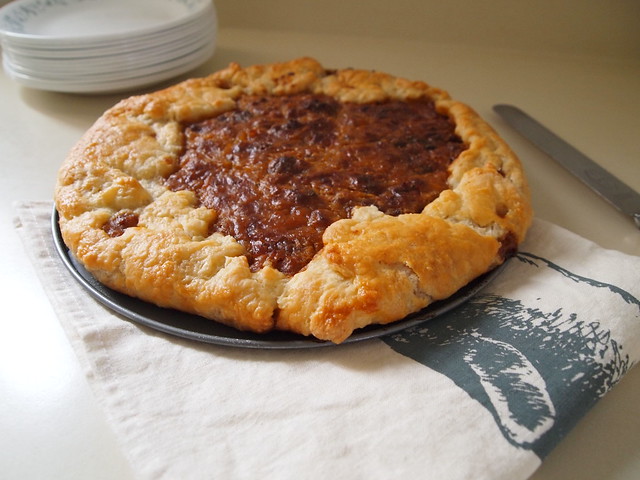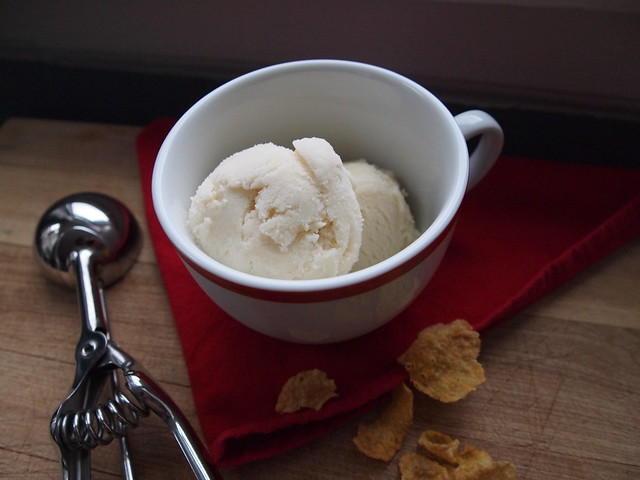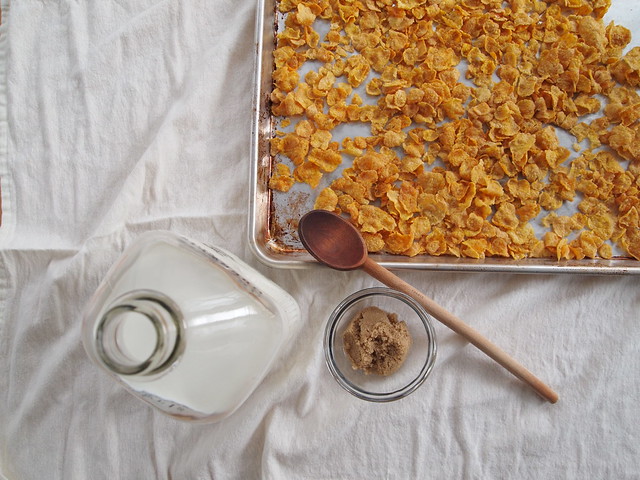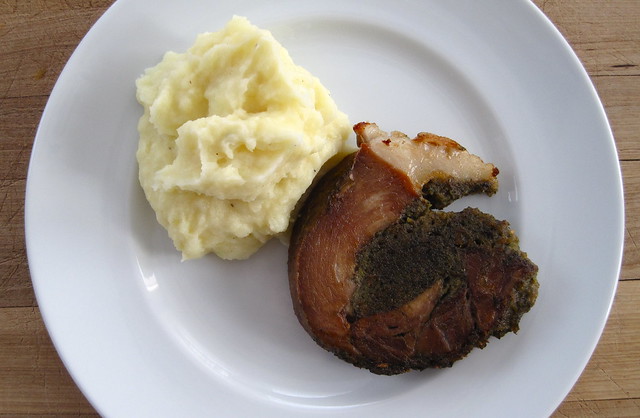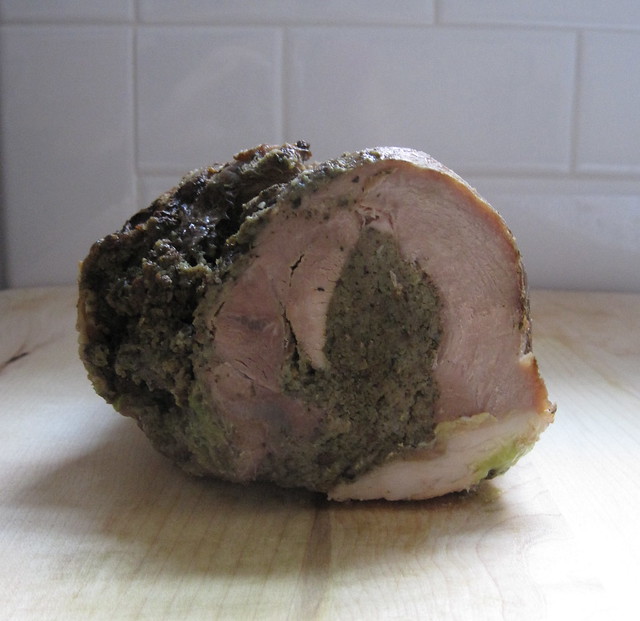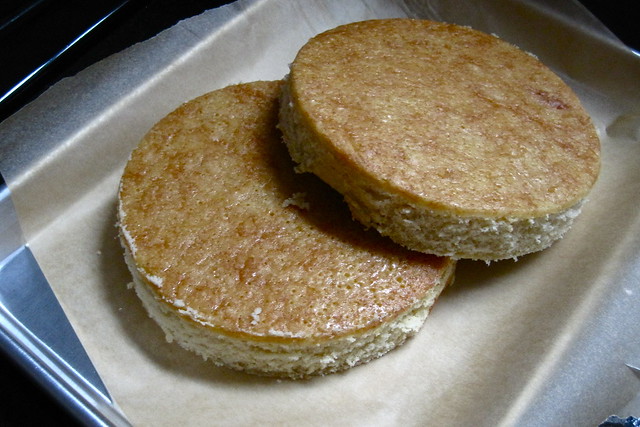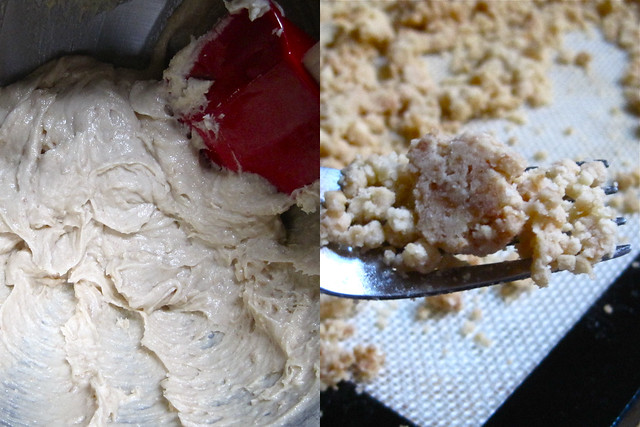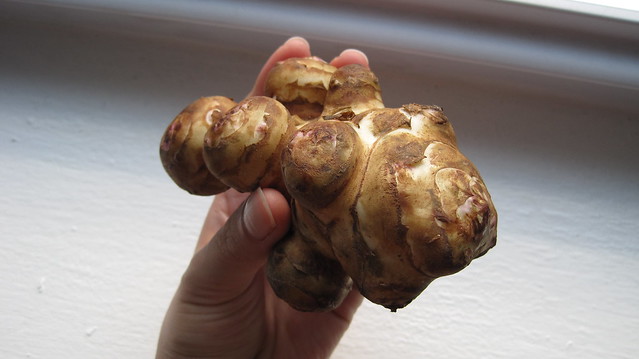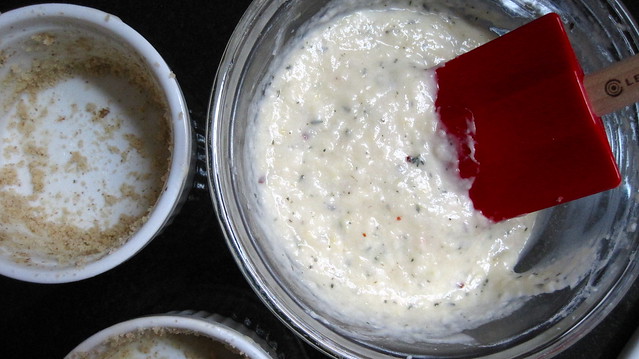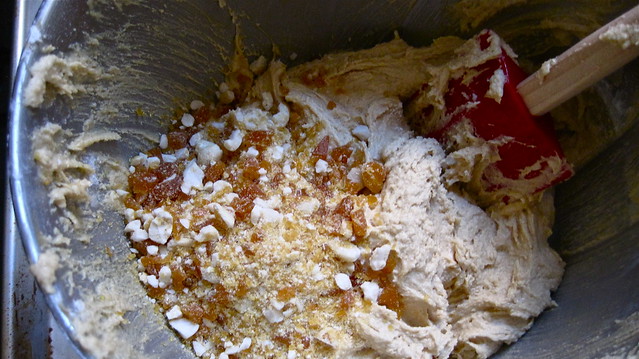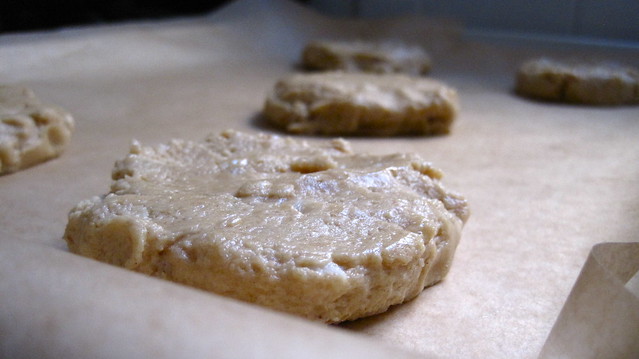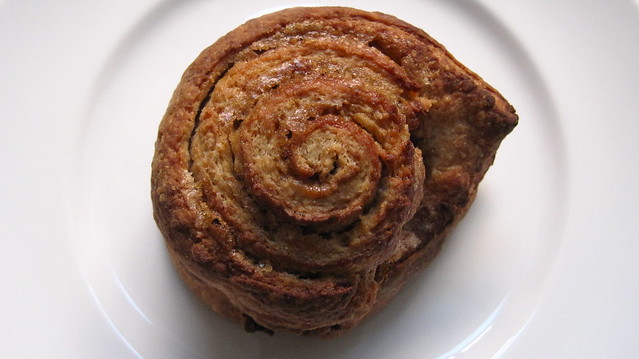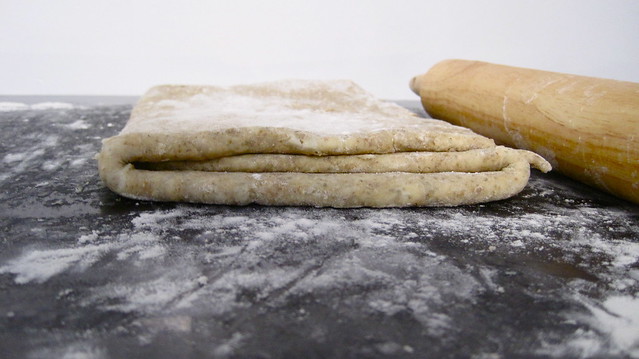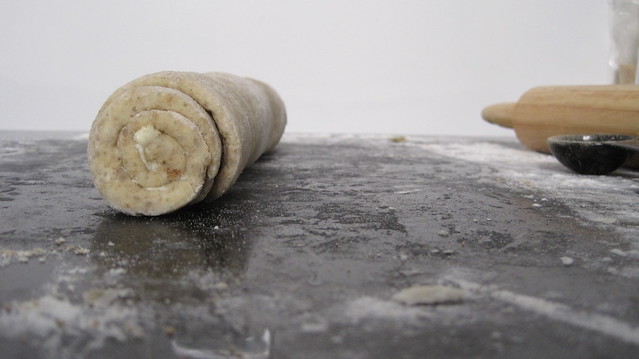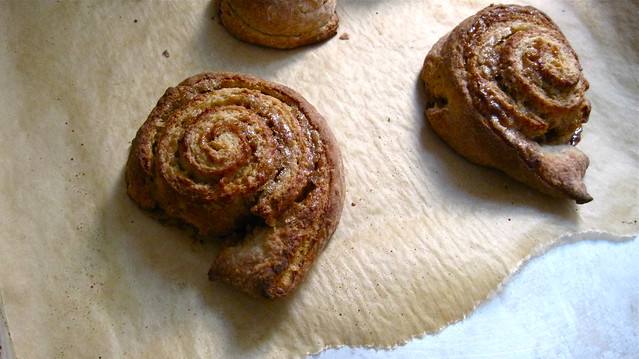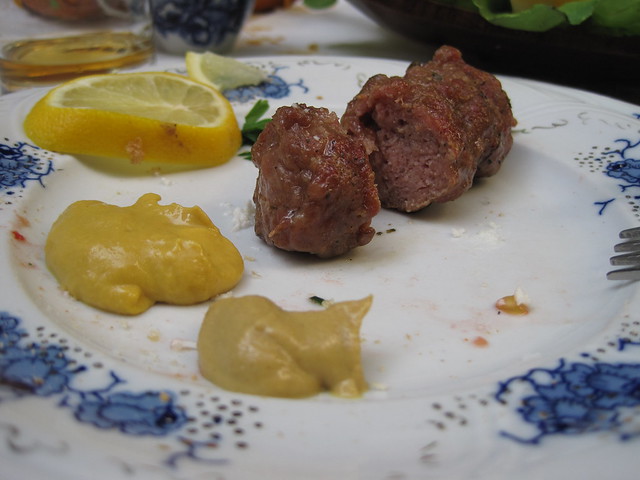Two nights ago, we had over our first dinner guests since the move to the new place. It felt good to finally have a proper dinner party, drinks, dessert, and all. Our guests were a couple I've mentioned before--the two who stayed with us in March for the philosophy department's
prospectives' week and who came back to the new place day after day late this summer to help with
painting. They've become good friends--loving food as much as we do probably didn't hurt. Between that first week in March when they showed up on our doorstep and now, we've shared a lot of food together--everything from cold lentils shovelled down between coats of paint to the best bacon ever (where else but at the
Publican). They're always up for pretty much anything, especially if there's something delicious involved. We get one another out of our sleepy neighbourhood and into the city. They're good friends to have. So it was only appropriate that they were our first dinner guests.
Dinner was a warm, stewy collard cobbler, which you can read all about over
here--perfect for the end of a wet and blustery day like the one we had, straight-up comfort food. Dessert was pretty much the opposite. You'll have to forgive me. I don't get nearly as many excuses (or have as much time) as I'd like to play with dessert, okay? And besides, this happened to be a belated-birthday dinner too. Cake was a must, the fancier, the better.
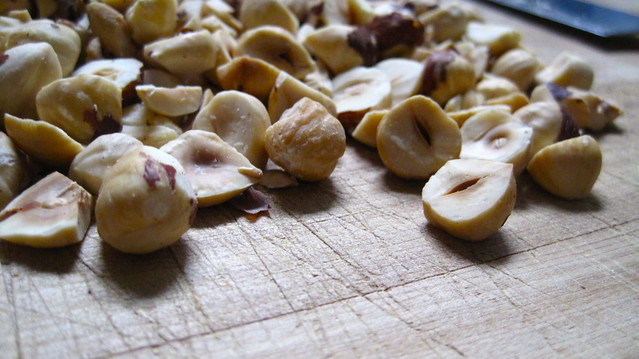
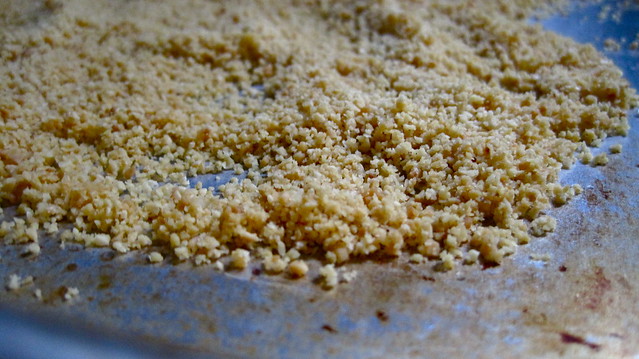
I went with something from a cookbook I've been meaning to talk about for a while now,
Mission Street Food. Now, most cookbooks are not good reads, not even the good cookbooks. I don't mean this as a complaint--they are cookbooks, after all. But
MSF is a great read. There's a pretty wild story behind the food (think: Bar Tartine cook and his grad-student girlfriend serving gourmet eats out of a borrowed taco truck and then, when that doesn't work out, out of a borrowed Chinese restaurant one night a week while the restaurant is still doing take-out), and the writing is hilarious. But, maybe, what I like best about it is how no-nonsense and matter-of-fact it is. Anthony Myint and Karen Leibowitz are not out to warm your heart. They tell it like it is, and often, it just happens to be funny. Even the instructive bits of the book make for good reading. Take this bit about sauces: "Armed with a powerful blender, you can make a lot of the components that separate fine-dining from Schmapplebee's or SchmeeGIFriday's. [...] If you start on a setting that's too high, your contents will splash and you'll have to wipe down the edges of the pitcher with a spatula, so be cool, but not too cool, because you're on the clock and there's no point in blending on Medium-Low for eight seconds while you build up the courage to shift to Max. After all, it's called the Vita-Prep 3, not Prince Wuss-o-Matic the Third." See, instructive and entertaining.
One more thing: MSF is not an everyday sort of cookbook--though Myint and Leibowitz were not exactly working in ideal conditions, the MSF team cooked serious restaurant food. They were practically minded (they even list an approximate cost for every recipe in the book) and couldn't quite do everything the "right" way, but they still managed to do some wild stuff. Peking duck, anyone? Mozzarella mousse? Triple-fried potatoes? A little out of my league for the moment, which was why I stuck with dessert.
Oh right, dessert--I made MSF's brown-butter financiers and served them with a rosemary-infused chocolate ganache and hazelnut-brittle pebbles. Sound complicated? Let me let you in on a little secret: it isn't really. There are three parts to it, none of which are particularly technically challenging. Block your time properly, have a little patience, and soon you'll find yourself left with just the plating to do. Make it pretty.
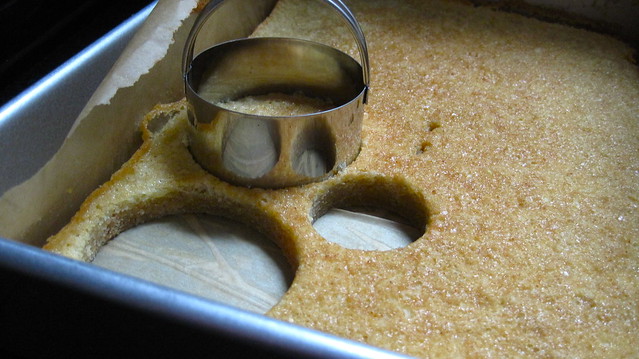
First component, the financier--if you've never had one before, a financier is a delicate but intensely nutty French cake. With all of the egg whites in it, it's kind of like sponge cake. You start by browning a good amount of butter over the stove. Meanwhile, you toast some almond flour. Two kinds of nutty goodness! Then it's just a matter of those egg whites, some cake flour, and some powdered sugar. Bake all of that in a 9 x 13 inch pan for a half hour, and you're set. Grab your favourite biscuit cutters and stamp out pretty shapes to your heart's delight. (If you eat the scraps while you're working, I won't tell.) By the way, Mission Street Food estimates that the financiers will run you about $8 for all the ingredients.

Second component, the hazelnut-brittle pebbles--making brittle is a pretty quick and painless process. You just need a bit of nerve (boiling sugar always scares me a little) and a candy thermometer. Have your ingredients measured and ready at hand to add to the mix--toasted hazelnuts (skins off, as best you can manage) and baking soda (for texture)--and don't walk away from the stove. The sugar can get hot fast. If you manage not to drop your wooden spoon on the floor and splatter bits of hot candy all over the place, you'll have done better than I did. Pour the brittle over a half-sheet, wait for it to cool, and break it into cute, bite-sized pieces. You'll have a lot of extra to snack on. Treat yourself.

Final component, the rosemary ganache--this one is really easy. When you're just about ready to impress your guests, drop a modest sprig of rosemary into a saucepan with some heavy cream, bring it to a boil, pour it over your best finely chopped chocolate, and stir. The ganache should be luxuriantly smooth and shiny. Don't forget to pick out the rosemary. Grab an angled spatula and smooth the ganache over your financiers.
Financiers? Check. Hazelnut brittle? Check. Rosemary-infused ganache? Check. Now, arrange all of it prettily on some clean plates and finish them off with some vanilla ice cream. And, if you want, you can get really fancy and make
quenelles out of the ice cream. All you need are two spoons and some practice (there's a good instructive video
here--one thing that it doesn't mention is that dipping your spoon in hot water really helps. If you're really good, like this
guy, you don't even need two spoons.). And there you have it, delicious, fancy-pants dessert. Lick the ganache off your fingers and pat yourself on the back.
Adapted from Mission Street Food: Recipes and Ideas from an Improbable Restaurant
Note: About the almond flour. I blanched and ground my own raw almonds for the batter, and the cake turned out fine. I suspect, however, that it would have had an even more delicate crumb with proper almond flour. Grinding almonds into flour at home is always a bit tricky--you don't want to end up with almond butter. But if you can't be bothered with buying almond flour, blanch your raw almonds in boiling water for 1-2 minutes and drain. The skins will slide right off after that. Just give the almonds a squeeze. Let them air dry or pop them in the oven for a few minutes, then grind them as fine as you can manage in a food processor. Make ahead. As MSF says, the cake batter will keep just fine in the fridge for a couple of days. Leftover cake will be good for a day or so, tightly wrapped at room temperature.
2 sticks / 8 oz unsalted butter
1 1/4 cups / 5 oz almond flour (alternatively, try hazelnut or chestnut flour)
3/4 cup / 3.15 oz cake flour
2 1/4 cups / 9.75 oz powdered sugar
8 egg whites
Heat the butter in a saucepan over medium heat until it turns brown and nutty, stirring frequently. Set aside.
Place the almond flour on a parchment-lined tray and bake at 350 degrees F until golden, about 12 minutes.
Grease a 9 inch by 13 inch pan with butter and line with parchment.
Sift the cake flour and combine with the toasted almond flour.
Mix in a stand mixer with the whisk attachment for 30 seconds.
Add the egg whites and mix for a few minutes, until thoroughly incorporated.
Add the butter (including browned bits) and mix thoroughly. Then add the powdered sugar.
Once the sugar is incorporated, pour the batter into the lined baking pan.
Bake for about 30 minutes at 350 degrees F. The cake is done when it has developed a golden and pleasingly crusty exterior. A toothpick inserted in the middle should come out clean. Let cool.
Hazelnut Brittle
Adapted from Tina Ujlaki at
Food & Wine
Note: If you're starting with raw hazelnuts, toast them at 340 degrees F for 15 minutes on a half-sheet. Then, collect them into a large sieve and, using a clean dish towel, roll them against the surface of the sieve to remove their skins. This never works perfectly, so don't obsess about it.
1 cup / 6.85 oz sugar
1/4 / 2 oz cup water
4 tablespoons / 2 oz unsalted butter
2 tablespoons + 2 teaspoons / 2 oz light corn syrup
1/4 teaspoon baking soda
1 1/4 cups / 6 oz toasted hazelnuts, skins removed, roughly chopped
Fleur de sel or crushed Maldon sea salt
Generously butter a half-sheet.
In a large saucepan, combine the sugar, water, butter and corn syrup and bring to a boil. Cook over moderately high heat, stirring occasionally, until the caramel is light brown and registers 300° on a candy thermometer, about 10 minutes.
Remove from the heat and carefully stir in the baking soda. The mixture will bubble. Stir in the nuts, then immediately scrape the brittle onto the buttered half-sheet. Using the back of a silicone spatula, spread the brittle into a thin, even layer. Sprinkle with salt.
Let cool completely, about 30 minutes. Break the brittle into large shards. Stored in an airtight container at room temperature, the brittle will keep for a month.
Rosemary Dark-Chocolate Ganache
Note: Make the ganache at the very last minute before you need it. If for whatever reason you do find yourself with leftover ganache, you can keep it covered in the fridge and reheat it the next day. Gently melt in a heat-proof bowl over simmering water. If the ganache starts breaking, you've applied too much heat--but don't worry, just whisk it vigorously, and it should come back together.
3 oz good bittersweet chocolate, finely chopped
2.75 oz heavy cream
1 modest sprig of rosemary
Place the chocolate in a medium heat-proof bowl.
Bring the rosemary and cream to a boil in a small saucepan over medium heat. Pour the cream over the chocolate and stir until the ganache is smooth and glossy. Remove the rosemary sprig.
Final Notes on Assembly, Etc. Cake. Cut the cake however you'd like. I thought concentric discs would be fun, so I took out my biscuit cutters. Think of it as sculpture. Stack your financiers. Lean them against one another. You've got a lot of cake, so go crazy. MSF says that you can get 12 servings out of the cake, but I think it really depends on how you want to present it. I'd say that you can probably get six 8-inch discs out of it, plus an assortment of smaller ones. Save the scraps for snacking on. They're tasty. Brittle. Make the brittle ahead of time and feel good about yourself. It will keep for up to a month. For plating, break it into small, bite-size pieces and scatter those. Ganache. Spread a thin layer of ganache on some of the financiers before serving, just enough to cover them. You don't want to overwhelm everything with chocolate.
Finish with a few rosemary needles as garnish. Serve with vanilla ice cream. Make quenelles, if you like.
Variations: MSF notes that the financiers play well with most things, especially fruit. They, for example, suggest blueberries, pine-nut brittle, mint leaves, and mint ice cream. I think vanilla poached pears would do it for me at this time of the year. This cake is versatile.


